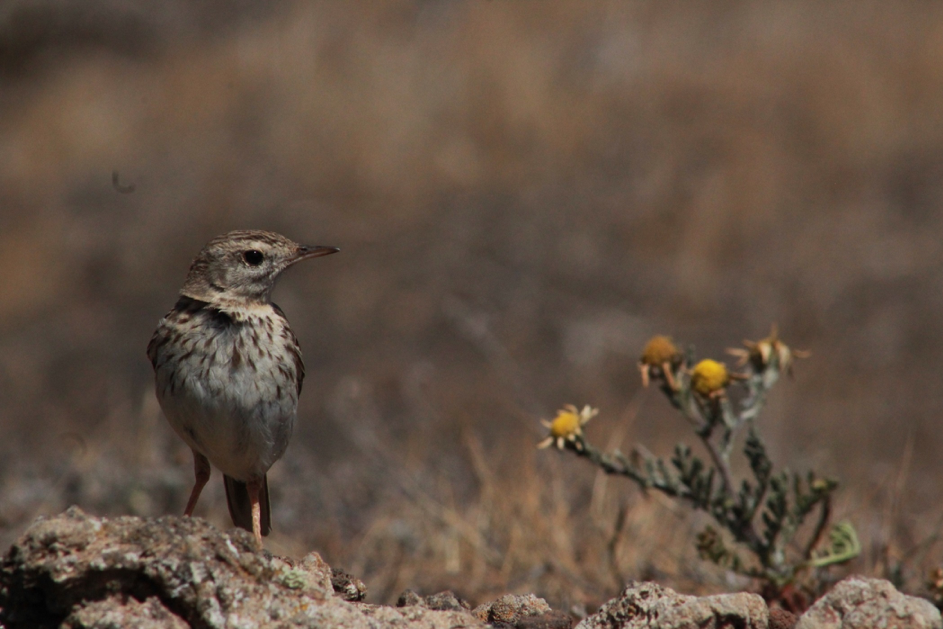
Patiently waiting for pipits in the “greener” North of Lanzarote
Changing environments, genes and “survival of the fittest”
As we face an elevated rate of biodiversity loss globally, largely due to changes in climate and habitat degradation, it is becoming increasingly important to understand what drives species to adapt to changing environments. What allows some individuals or populations to thrive while others are unable to adapt, and ultimately face extinction? The answer lies not only in ecological and anthropogenic factors but also with species biology.

This is where genetics has the power to do something really exciting. DNA sequencing allows us to determine the complex four letter code (AGCT) that allows our genes to behave in a particular way, resulting in different expression of trait characteristics. This sequence can also tell us about the number of individuals in a population due to levels of variation within the DNA code. My work focusses on detecting genes that have unusual patterns of variation compared to the rest of the genome (fancy word for an individual’s entire DNA code). These regions are of particular interest as natural selection may act on these genes because they effect traits (such as body size) that may benefit an individual’s survival in a particular environment. Therefore, DNA acts as a record for how species adapt to their environment, this type of work takes “survival of the fittest” evolution all the way down to the genetic level – an incredibly powerful tool. By using the DNA sequence in this way for wild populations, we can begin to understand how species adapt in response to changing ecological pressures, and which species are vulnerable to population loss.
Why Islands: unique, biodiverse and vulnerable
Islands provide unique and biodiverse landscapes, with a high proportion of endemic species which are particularly vulnerable to extinction. It is therefore of acute conservation concern to understand what factors maintain and promote their biodiversity. As well as being extremely biodiverse, oceanic islands provide replicated, ecologically variable landscapes across which we can study adaptation in the wild.
The Berthelot’s pipit, Anthus berthelotii, is a small bird endemic to three groups of islands in the North Atlantic; Madeira, Selvagens and the Canary Islands, across which ecological pressures vary substantially. Fine-scale differences in ecological communities, island topography, pathogens, anthropogenic factors and climate, result in a unique combination of selection pressures across this species’ geographic range. What makes this system perhaps even more interesting is that ecological variation is greater between closely located islands, than between islands separated by hundreds of kilometres of ocean.

Infectious disease and parasites pose a major challenge to wild populations, often exerting strong fitness costs to infected individuals by reducing reproductive success and survival. Avian malaria and pox are wide-spread across the populations and infection rate varies substantially - 70% of Lanzarote birds were infected with malaria this year, whilst some other islands have no confirmed cases of infection.
Genomics to understand adaptive evolution – environmentally important traits?
To investigate adaptation across these populations my project has focussed on “scanning” the genome for genes under selection, to determine traits of adaptive importance across these populations in the wild. I have been using a combination of whole-genome and low genome coverage RAD-sequence data for pipits across the islands. Whole-genome data provides information on all of the genes (as well as non-coding regions) within the genome and is very expensive. While RAD-sequence gives us data on a small proportion of the genetic information (typically 1-5%), but is much cheaper and can therefore be used for many more individuals. Using these data types together maximises the number of DNA sites (molecular markers) and number of birds that I can study, allowing me to ask more exciting questions.
On a voyage to entice some pipits….
During Spring 2019 we visited Lanzarote to sample some more pipits. We were particularly interested to visit this island as there is a north-south habitat gradient and high levels of disease recorded on previous visits by my supervisors in 2006 and 2009. Pipits were caught across the island using baited spring traps. Despite the presence of a tasty worm, it was surprisingly hard to entice the birds! Locally the pipit is known as “the Roadrunner”, as they prefer running along the ground than flying short distances. Using this behaviour to our advantage, we worked out that slowly herding the birds near to the traps and then letting them stumble across the food had the greatest chance of success.

Success! Catching pipits in our tent-like Spring traps.
With help from my fellow pipit herders we were able to collect body measurements (bill, wings, weight etc.) for the 83 birds sampled, along with blood samples, for DNA sequencing, and faecal and pox lesion samples for disease screening. In the molecular lab I have been identifying the sex and infection rate of the birds across this population. By DNA sequencing pathogens from the blood samples we have identified the strain of infection, it's likely origin and any genetic variants which may be as a result of pathogen-host selection and evolution.

What can genomics offer for the future of conservation and evolution?
So what can herding birds in the Canary Islands tell us about how to protect species in our ever changing world? As I write this, the high throughput technologies used to generate this data are becoming steadily cheaper with improved accuracy, opening up a new and exciting avenue only partially explored for conservation applications. Genomics can be used to give accurate estimates of population sizes deep into evolutionary history over thousands of generations, to identify drivers of population decline and inbreeding which will be a critical factor in saving some species from extinction. As these technologies become more accessible and our desire to protect the natural environment appears to be gaining traction, I am excited to see what new opportunities this provides for biodiversity conservation.

Comments